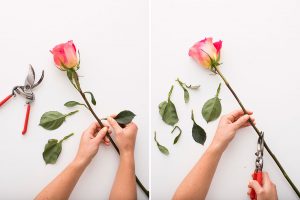Whether you’re gathering flowers from your garden or you buy at a florist, take a few simple steps to condition them. The process helps them stay fresh and beautiful, so you can enjoy them longer.
The Basics
If you cut flowers from the garden yourself, it’s best to do so in the morning, before the heat of the day affects the blooms; bring a bucket of water with you to put the stems into right away. If you are buying flowers, it’s generally a good idea to choose ones that are more tightly closed (think roses); they will likely last longer. Once you get them inside — from the garden or flower shop — fill a large, deep vase or flower bucket with cool water and add commercial flower food. Then follow some of the steps to prepare the flowers. Place the stems in the water immediately. If you have time, soak them in water for several hours and up to overnight to hydrate and fortify them. Then arrange them in clean vases with more water and flower food. Change the water every day or two, adding more flower food each time. If the water looks at all cloudy, scrub the vase well to kill any bacteria, and recut the stems before returning the flowers to the vessel.
For All Flowers
Make a fresh cut. Trim stems at a 45-degree angle using sharp shears, snippers, or a pocket knife. The angled cut provides more surface area for drinking up water and prevents stems from sitting flat in the vase. If flowers that grow from bulbs (like tulips) have thick white stem ends, cut them off. For best results, cut stems with a sharp knife at an angle about one to two inches from the bottom. This allows them to better absorb water. Do not use scissors to cut your flowers because they can crush the stems and prevent water absorption. It’s a good idea to trim a bit from the stems each day or every other day to help the flowers receive a steady flow of nutrients and water.

Remove foliage. Remove any greenery from the bottom of the stems that will be submerged in the water — you’ll be amazed at how much removing lower leaves will help keep the water clearer. Strip off leaves that would be underwater in the vase (leaves will rot if submerged, giving rise to bacteria that shortens flowers’ life).
Woody Stems:
Split stems. With lilacs, dogwoods, azaleas, forsythias, crab apples, and other flowering trees, cut the stems vertically an inch or two from the bottom to let them drink up more water.
For Milky Stems:
Seal ends. With poppies, euphorbia, hollyhocks, zinnias, sunflowers, and other flowers with a milky sap in the stem, use a match to sear cut ends, or dip them in boiling water. This stops the flow of sap, which can clog the stem and prevent it from taking up water.
For Roses:
When shopping for roses, gently squeeze the rose where the petals meet the top of the stem. If it’s soft and squishy, the roses are old and you shouldn’t buy them. If it’s firm, the roses are fresh.
Remove thorns, working from the top down, pare them off with a small, sharp knife or a stem stripper.
Revive blooms.
If roses look limp, give them a good dose of hydration. Soak them in cool water for a few hours, covering the stems with a towel to submerge them. It’s fine for some of the petals to also be submerged.
Tulips
Perk them up. Inserting a pin through each stem just below the head will allow air to escape and encourage the flow of water.
Carnations
Snip at the right spot. Cutting the stem of a carnation (or baby’s breath or sweet william) cut above a node will help it draw more water.
